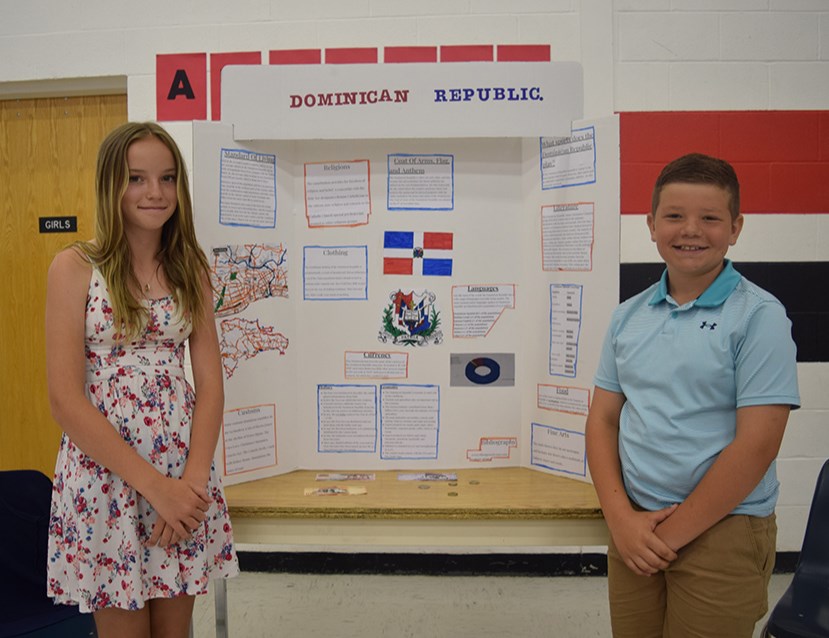CANORA - The school year normally includes a wide variety of assignments, but for Grade 6 students at Canora Composite School, what might be their most interesting and challenging assignment of the year is the International Bazaar.
Students, mainly in pairs, were asked to choose one of the Atlantic countries for the assignment, which includes Africa, North and 小蓝视频 America, and Europe, according to Jennifer Sleeva, teacher. Their findings were then presented to family, friends and teachers in attendance at the International Bazaar in the school gym on June 13.
“They are asked to compare what we know about Canada to other countries; how we are the same, how we are different,” said Sleeva. “It’s a big world out there, and this is a chance for them to learn to think globally.”
Denmark
Mason Reine and Cameron Sznerch decided to focus their project on Denmark. A definite motivating factor was the Sznerch’s ancestors are Danish.
“One of the interesting things we found out is that one cent in Danish money is only worth 0.19 cents Canadian,” said Reine, “so a Canadian could buy a lot of stuff in Denmark.”
While there are a lot of differences between Danes and Canadians, one similarity is that both enjoy board games.
“We found a board game from Denmark that is quite similar to our game called Monopoly,” said Sznerch.
In addition to board games, Danes enjoy physical activities such as bowling and basketball. Culturally, many enjoy participating in vocal choirs. Denmark’s most popular sport is soccer, which is known as football there.
Reine and Sznerch discovered that Danes very much enjoy their customs and rituals. On New Year’s Eve, the custom is for everyone to jump off a chair at midnight. Then in spring, most Danes will write Easter letters to each other. In Demark, a person doesn’t want to be single by the time they hit 25, because on that milestone birthday, there’s a good chance you’ll be dragged out to the street and covered in cinnamon.
Cuba
Seneca Crane has Cuban relatives and he likes chess, so it didn’t take long for he and his partner Caden Doogan to choose Cuba as their focus country.
Unfortunately, Crane was absent on the day of the International Bazaar, but Doogan proved they had done a lot of research.
“Cubans like to play chess,” said Doogan. “They also enjoy fishing, dominoes and card games. There are a lot of old cars still driven in Cuba, many don’t even have a roof anymore.”
There is quite a bit of poverty in Cuba. “They don’t have very many fancy stores like Yorkton,” is how Doogan made the comparison.
Baseball is the most popular sport in Cuba. Numerous players who found initial success there, left for North America to play Major League Baseball, where there is more of a chance to provide financially for themselves and their families.
Cuba is an usual country geographically, measuring about 1,200 km long by only about 100 km wide.
Under the former Castro regime, Christmas was outlawed for approximately 30 years. Even now, few people go to Church on Christmas or attend a celebratory service in Cuba. The majority of the country cannot afford to attend the fancy Christmas parties held by restaurants and nightclubs.
Norway
Tessa Prychak and Lilith Shewchuk didn’t know much about Norway, and said they liked the idea of exploring a country where there was some mystery involved.
“They love their winter sports in Norway,” said Prychak. “Their biggest sports are cross-country skiing and hockey.”
Prychak and Shewchuk discovered that Norwegians really value their food, which makes sense, because skiing and hockey require a lot of energy. A typical breakfast in Norway consists of cereal, meat, herring, cheese, and buttered bread with jam.
Shewchuk was surprised to discover Norwegian marriage statistics. “About 40 per cent of marriages end in divorce. On average, men marry at 39 and women at 36 years of age.”
Traditionally, Norwegians have a distinct sense of fashion. Women normally were headdresses, jewelry, blouses, belts, skirts and aprons. Men are usually attired in hats, jackets, vests, trousers and stockings.
Norway’s head of state is King Harald V and the prime minister is Jonas Gahr Støre. Norway is a parliamentary constitutional monarchy, similar to Canada.
Dominican Republic
Like many of their classmates, Clare Ruf and Reid Kitchen were looking for an unfamiliar country where they had a lot to learn.
“We didn’t know much about the Dominican Republic, so that’s what we chose for our project,” said Ruf.
They discovered that common activities include sports such as volleyball, swimming and basketball, but baseball is the favourite sport for most Dominicans.
When it comes to food, La Bendera is the national dish. Its colours match the colours of the Dominican flag, including: rice, red beans, meat and salad.
The main colours of the Dominican flag are red, blue and white. Kitchen said their research indicated that each colour is of great significance to the country’s residents.
“Red is for blood spilled by the fighters in the War of Independence,” said Kitchen. “Blue is the sky above the country and from where God protects the nation and its ideas of progress, and white is for peace and union of the Dominicans.”
Ruf and Kitchen each indicated that they would like to visit the Dominican someday to “see what their homes are like and try the food.”




